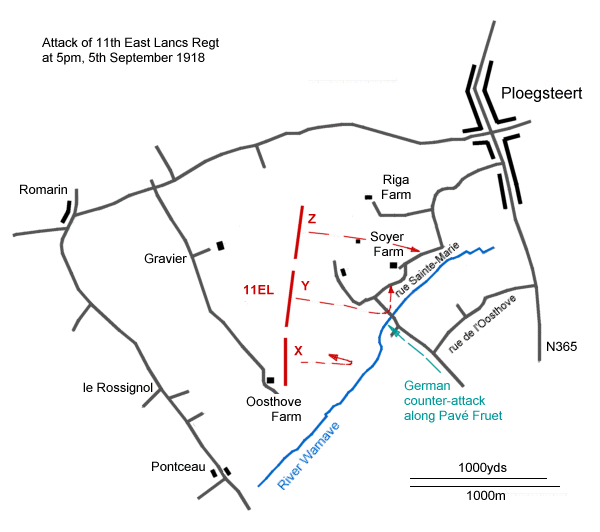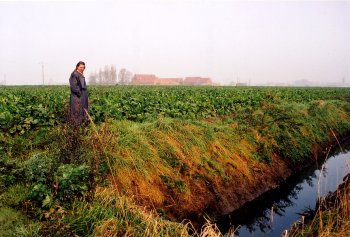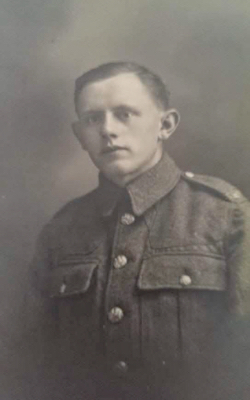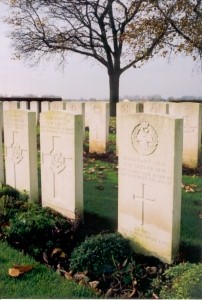
180° panorama looking north-west from the road bridge over the River Warnave. Soyer Farm is the red-brick group of buildings to the right. The fifth and last German offensive of 1918, a two-pronged attack delivered astride Rheims, was brought to a halt on 17th July. The tide turned decisively at Amiens on 8th August when Australian and Canadian infantry of the British 4th Army, covered by over 500 tanks, drove through the German lines to a depth of 6 to 8 miles. Throughout August the Allies gradually recovered the ground lost since 21st March, taking 150,000 prisoners, 2,000 field guns and 13,000 machine guns in the process. After the success at La Becque, the 11th East Lancashire Regt. (Accrington Pals) remained stationed in the vicinity of Aval Wood throughout July and much of August; towards the end of this period, patrols succeeded in capturing several enemy posts and advanced the line by about 200 yards. After a spell in Divisional Reserve, 92nd Brigade1 took over the front line between Ploegsteert and Nieppe on the night of 3rd/4th September. At 8.35am on 4th September, patrols from the 10th East Yorkshire Regt. began to push towards the River Warnave on a frontage of 2,000 yards. On the right, "B" Company was unable to make any headway as enemy machine gun fire swept across the open, flat countryside. Despite the absence of any artillery support, some degree of success was achieved on the left and centre of the attack where "C" and "D" Companies had advanced the front line to around 500 yards east of le Rossignol and Gravier by 11am. A further attack was sent in at 3pm but was soon called off in the face of strong enemy opposition. The 11th East Lancashires took over the line during the night and at 4.30am on 5th September patrols were sent out to probe the enemy's defences in front of the River Warnave. By noon, Pontceau and Oosthove Farm had been occupied on the right and in the centre while on the left the enemy had been driven out of Riga Farm. Further progress was prevented by heavy machine gun fire from the farms and enclosures 400 yards (370m) west of Soyer Farm.  The attack was renewed at 5pm under cover of a creeping barrage, the platoon occupying Riga Farm having first been withdrawn in order to allow the barrage to move on a north-south line. "Z" Company attacked on the left with "Y" Company in the centre and "X" Company less two platoons on the right. The first waves moved forward as soon as the barrage fell. At the same time, heavy enemy machine machine gun fire broke out from the right flank. The two platoons of "X" Company encountered thick wire almost immediately and lost touch with "Y" Company when mounting casualties brought them to a halt. Elsewhere the enemy quickly abandoned their forward positions, making a moderate stand 200 yards to the rear, especially at Soyer Farm where 10 prisoners and a machine gun were taken after coming under enfilade fire from a Lewis gun team commanded by Cpl. Robert Walmsley.2 Supported by Lewis gun fire, "Y" and "Z" Companies reached the line of the River Warnave by 5.40pm and attempted to consolidate. Sgt. Roger Ireland won the Military Medal here, having led his company forward to its objective after all its officers had become casualties.3 The gap between "X" and "Y" Companies had not been closed when the enemy swiftly counter-attacked up the Pavé Fruet and gradually worked around the right flank of "Y" Company killing or capturing the whole of the right platoon. The remainder of "Y" Company fell back to the line of the rue Sainte-Marie but there held firm, driving back the enemy with Lewis gun and rifle fire. Some 20 prisoners and two machine guns had been captured in the day. At least 1 officer and 28 other ranks of the 11th East Lancashires lost their lives; 3 officers are reported to have been taken prisoner in the battle: 2/Lt. Harold Duckworth Walmsley, 2/Lt. John Marshall and 2/Lt. Thomas Crook Atkinson. Among other ranks taken prisoner was Pte. Albert Duxbury.
The East Lancashires occupied the front line on three more days before being withdrawn to Divisional reserve north of Hazebrouck on the 13th. The battalion then remained at Hazebrouck until the 24th when it was again moved forward in preparation for an attack at Ploegsteert Wood. The Battlefield Today From the crossroads in Ploegsteert, take the N365 south towards Armentières. After 0.6 mile, turn right onto the rue de l'Oosthove (Oosthovestraat). Turn right at the T-junction, and stop where the road crosses the narrow River Warnave. This is the road along which the German counter-attack was directed. The collection of red-brick farm buildings directly to the north are on the site of Soyer Farm. A good impression can be had from this point of how exposed the battalions of 92nd Brigade would have been been as they advanced across this open and flat terrain. Continue over the river and turn right on to the rue Sainte-Marie (Sint-Mariastraat) at the next T-junction. It was to the line of the rue Sainte-Marie that the 11th East Lancashires fell back in the face of the German counter-attack. The road leads back to the N365, a short distance south of the Ploegsteert crossroads.
© Andrew C Jackson 2001-2002 Compiled from TNA documents WO95/2343, WO95/2356, WO95/2357, "The History of the East Lancashire Regiment in the Great War" edited by Major General Sir N. Nicholson, "The East Yorkshire Regiment in the Great War" by Everard Wyrall, "List of British Officers taken prisoner in the various Theatres of War between August 1914 and November 1918", compiled by Cox and Co., 1919, and with the kind help of David Ingham and Ryan Walmsley.
|




